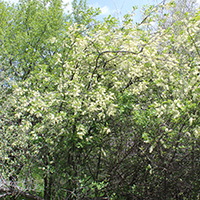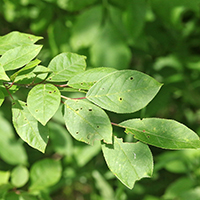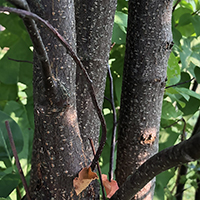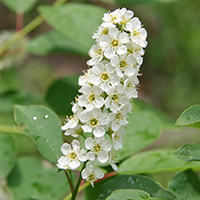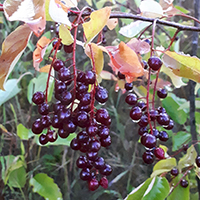What chokecherry looks like
Size and shape
- Reaches 9 metres high.
- Trunk up to 15 centimetres in diameter.
Leaves
- Green, oval leaves with sharply toothed margins (5 to 10 centimetres).
- Tapered at both ends.
Bark
- Dark grey to brown bark.
- Smooth or covered in fine scales.
- Becomes almost black with age.
Flowers
- White flowers grow in dense, elongated clusters (8 to 15 centimetres).
- Bloom before new leaves fully develop.
Fruit
- Chokecherry fruit (8 to 10 millimetres) grow in clusters of 6 to 12 and range in colour from yellow to crimson to black.
- Ripen in August or early September.
Where chokecherry is found
Chokecherry is found throughout southern Ontario and on the Canadian Shield from Quebec to Manitoba.
What you need to know to grow chokecherry
- Moisture: grows best in moist soils.
- Soil: adapts to many soil types.
- Shade: grows best in full sun but tolerates partial shade.
- Cautions:
- Chokecherry pits are toxic to humans and wildlife when consumed in large quantities.
- Chokecherry branches are weak and can easily break or become damaged during storms.
Benefits and uses of chokecherry
Wildlife benefits
Chokecherry trees are a food source for many species. Large mammals such as moose and elk browse leaves and twigs. Other mammals, such as bears and rabbits, and birds eat the fruit.
Commercial uses
Chokecherry trees are planted as ornamental and understory trees. The berries can be used to make jelly.
Fun facts about chokecherry
- Chokecherry trees can live 20 to 40 years.
- Chokecherries are bitter and sour, which may be where their name came from.
Updated: January 10, 2024
Published: July 17, 2014
